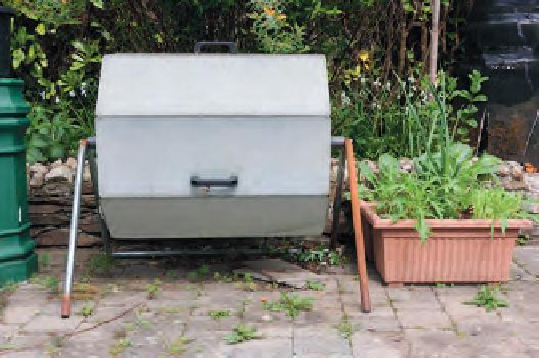Agriculture Reference
In-Depth Information
The compost is removed when ready; the decomposing
top layer is separated off and used to start the next run.
The compost is spread out to dry in the sun and the
worms are recovered by placing a wet newspaper on
the compost, under which they will congregate.
On a larger scale, wormeries are used to compost
farmyard manure, with continuous systems available
that separate the composted material from the
worms, which can be recycled with surpluses being
available as animal feed.
Composted municipal waste
When very large quantities of green waste from
households and parks departments are available, the
ingredients can be heaped up on a concrete base.
This makes it easy to use large powered equipment
to turn the ingredients to maintain good aeration. The
cooler outer layers can be mixed in to ensure all parts
are heated up and decomposed rapidly. Specialist
composting vessels with automatic turning equipment
and biofilter beds ensure that the exhaust vapour
is 'scrubbed' (cleaned). The main advantage of the
composted municipal waste is that high temperatures
can be achieved and so the material is less likely to
contain viable weed seeds, perennial weed material
or plant diseases. 'Windrow turners' are used in big
plants to turn and loosen the green waste. These tend
to dry out the material and so some are in housed
areas to confine the dust created.
Figure 13.4
Compost tumbler. Turning frequently
made easy by the use of a handle to rotate the load.
weeds and diseases and the enclosed nature deters
vermin. The compost ingredients should be gathered
together and the tumbler filled in a short space of
time. Nothing is added until the batch is completed.
Worm composting
This lends itself to handling small quantities which
can be added as they arise, such as kitchen waste,
especially over the winter period when there is
little plant material to accumulate. Brandling or tiger
worms (
Dendrobena
spp
.
and
Eisenia foetida
) are
compost worms that feed on organic matter. These
can be purchased, but they are readily found in rotting
vegetation such as compost heaps (see Figure 13.1)
and quickly multiply. Each kilogram of worms eats 1-2
kg of waste food per day.
The compost container can be a plastic dustbin usually
equipped with a tap to drain off liquids, which can
be diluted and used as liquid feed for plants. Smaller
containers, wide rather than narrow, can be made
out of wood, ideally with some insulation to maintain
temperatures. The worms eat the vegetation as it
starts to rot, which means that once in balance there
is no smell.
A 10 cm layer of sand is used at the base and it is
covered with a polythene sheet. Bedding material
such as well-rotted compost or farmyard manure
is needed for the worms to live in until the process
begins. Chopped waste is spread to a depth of 5 cm.
Around 100 worms are added and covered with wet
newspaper to keep out the light and maintain moisture
levels. A lid is needed to keep out the rain. Ideally,
temperatures should be maintained between 20 and
25°C and the pH kept between 6 and 8; lime can be
sprinkled on if the compost becomes too acid.
Hot beds
Using the composting process to generate heat has
been used since at least Roman times. The heat
generated in the hot bed process was much exploited
by Victorian gardeners to produce exotic fruits such
as melons and pineapples and to ensure a continuity
of supply of fruit and vegetables for the kitchen even
through the coldest months of the year. The Victorians
also had access to large quantities of fresh horse
manure that still remains the best material for a hot
bed system.
The emphasis of this decomposition is the generation
of heat so there has to be sufficient quantity of fresh
manure to complete the process in a short period of
time, days rather than weeks. Compare this with the
cold process where the build-up of a typical garden
compost heap is over months. The process is started
by building a loose heap, that is, plenty of oxygen
circulating. Within two to three days the pile heats up
and generates steam. At this point the pile is inverted
and 'fluffed up'. This is repeated three days later
sprinkling on water if necessary to keep the mix moist.

